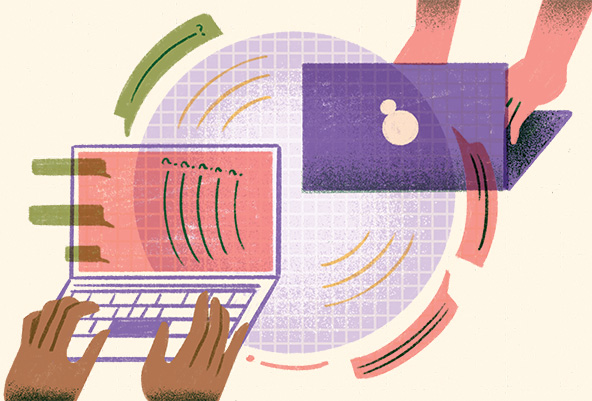Smart Nonprofits

(Illustrated by Vanessa Lovegrove)
The digital revolution that began two decades ago has enabled organizations to quickly and cost-effectively share information and communicate with large numbers of people over large areas. However, this digital connection and the response it provides came at a high price; The blurring of boundaries between work and family life has fueled demand. We are overwhelmed by the endless daily email battle. According to statistics, American employees check their email an average of 74 times a day.
The next generation of nonprofits

Cloud computing provides the innovations nonprofits need to better serve their clients, increase donor and member engagement, and improve stakeholder engagement. This appendix shows how your organization can use this technology to accelerate its success. Powered by AWS
A new chapter of digital is emerging that operates very differently from previous generations of digital technologies such as email. Email and social media have made workers' lives faster, but not necessarily better. This will free employees from time-consuming manual tasks that take up 30% of an employee's workday. This newly freed time allows nonprofits to focus on building relationships, sharing stories, and solving big problems. In other words, employees will be able to spend more time on meaningful work and less time on mundane tasks.
In our new book Smart Nonprofits, we define this next generation of “smart technologies” as the world of technology, including artificial intelligence (AI) and its subsets and cousins, such as machine learning and natural language processing, all based on today: cloud computing. . These technologies, not people, use datasets the size of the Library of Congress to find patterns and make decisions for people. Organizations use business apps today to display resumes, provide fact-based information, and answer common questions (such as “What time are you open?” and “Are my donations tax deductible?”).
The goal of using technology in organizations is not to do more faster, but to free people from labor-intensive tasks and create what we call a “time dividend,” which is the excess time gained by replacing smart technologies. Basic and repetitive tasks. This new time can be devoted to tasks and activities that only humans can do, such as strengthening relationships and solving problems. Or this time the profits will allow us to manage ourselves and our work for our own benefit and for the benefit of the work we do.
Articles in this series show how next-generation nonprofits are using cloud-based intelligence to improve the quality of their work and the lives of their employees. For example, Share Our Power, an organization dedicated to finding solutions to poverty, uses this technology to collect fundraising information. The famous non-profit art museum, Barnes Foundation, is dedicated to making art education accessible to everyone. And Charity: Water, a nonprofit organization dedicated to providing clean water to developing countries, is using smart technology to streamline processes to make access to clean drinking water more accessible. The common factor that connects the nonprofit efforts listed in this appendix is that each has organizational leadership that understands why, where, and when to use smart technologies.
bots
In addition to providing software, smart technology applications are available for all departments, from communications to accounting to service delivery. Effective use of this technology requires a deep understanding of what it is and what it does, as well as careful strategic thinking about how it can be applied to the organization to maximize the value of the technology and people. This extra dynamic is called coboting .
There are aspects of the job that lend themselves to automation, such as cutting and pasting data from one spreadsheet to another and analyzing huge datasets. But few of them can or should be completely replaced by smart technologies. What automation can improve is the user experience. Rather than doing the same work faster and with fewer people, smart technologies create opportunities to redesign jobs and reorganize workflows so that people can focus on the purely human aspects of work that matter most to companies. Non-profit missions.
Cobotization requires time and careful implementation. And when done right, the benefits to employees are enormous. A 2021 MIT study found that the benefits of adopting AI extend beyond efficiency and decision-making, with more than 75% of employees reporting improvements in teamwork, collaboration, and team learning. These profound cultural changes illustrate what can be achieved from the strategic and deliberate adoption of smart technologies. Philanthropy also explains in his article. Christoph Jorder, CEO of Water A culture that embraces the use of smart technologies requires an understanding of the opportunities and risks of using them.
Intelligent technologies make it possible to restructure work processes so that people can focus on the purely human aspects of work that are central to non-profit organizations.
Transitioning to smart technology requires managers to consider the implications of automation and make ethical decisions about using smart technology to bring out, not replace, the best in employees. This is why we firmly believe that the successful implementation of smart technology is primarily a leadership problem, not a technology problem. Successful integration of smart technologies requires that nonprofit leaders ensure the following conditions:
- Person Taken |: Always make sure people come first. This means that employees are trained to understand and use smart technologies well, and that third-party components know when and how to interact with smart technologies, rather than directly with people.
- Know the impact of smart technologies is greater than just the IT department. Board leaders, senior managers, and employees need to understand what smart technologies are and what they do. When implementing automated systems, managers must be vigilant of whether the technology is working as intended, whether there are unintended consequences, and how customers and end users ultimately feel about the systems.
- Reflective |: Managers need to understand when and how bias is embedded in the data or in the algorithms used to analyze that data. They don't have to be engineers. Instead, they should be critical of and question the assumptions behind the code and database origins. Selecting value-based systems, suppliers and consultants requires a deliberate participatory process. In particular, intelligent tech systems, because they are created by humans, may have built-in racial and gender biases. Organizational leaders must analyze the bias of these products and take steps to mitigate their potential harm.
beginning
Enterprise adoption of smart technologies is rapidly increasing. This trend is the result of falling technology costs, along with increasing commercial applications. Technologies that were only available to NASA a few years ago can now be used by museums, NGOs, and non-profit organizations of all sizes. This means that smart technologies are becoming a key component of not only what organizations do, but also who they are .
Here is an overview of how your organization can start using smart technologies:
Identify pain points to determine appropriate use cases. |: Intelligent technology should focus on areas where it can take over daily tasks, streamline unmanageable workloads, and reduce workload and stress on employees. Define which activities and decision-making processes will remain with employees and which activities will be automated after the system is implemented. This includes determining how automation will be controlled by someone skilled in the art.
Choose the right smart technology for the job. |: Ensure that the product or system you choose creates the correct cubot balance. Align the assumptions behind smart technologies with your values. Also, ensure that tasks that require empathy and knowledge are assigned to humans and that tasks such as entering data or analyzing multiple datasets are for intelligent technologies and not the other way around.
Create a virtuous cycle of testing, learning, and improving. |: Move carefully and slowly, because it's hard to undo the damage of automation when smart technologies are at work in the enterprise. Test the new system and workflow to test assumptions and goals.
Cloud computing and smart technologies have the power and potential to thrive in an age of frenetic activity and a scarcity mentality. We are entering a new era where nonprofits will have time to think, plan and even dream.
Read more stories by Beth Kanter and Alison Fine.


Post a Comment for "Smart Nonprofits"